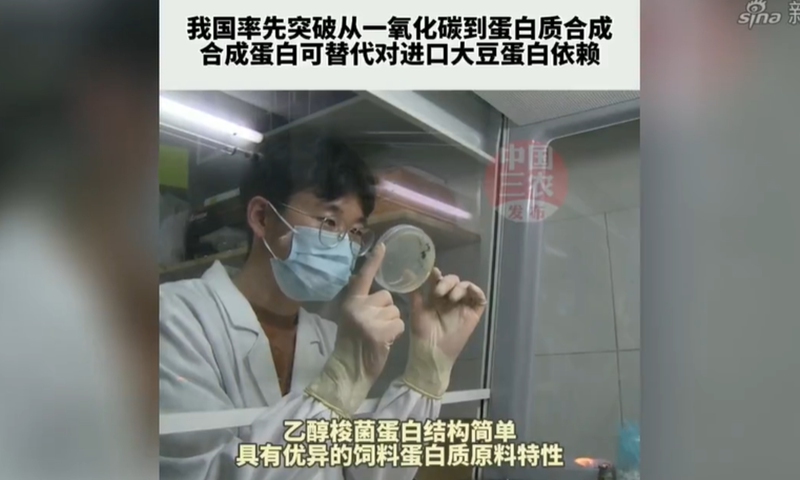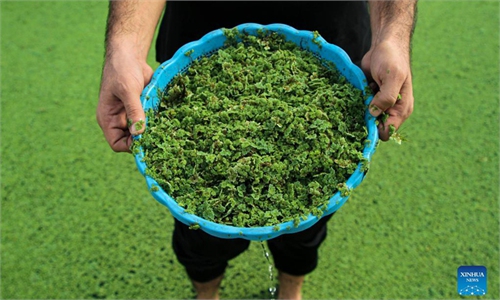Breakthrough made in animal feed industry, a further step toward reduction on carbon and external dependence: insider

Photo: Screenshot of Weibo video
China has made a major breakthrough in the field of biosynthesis, marking the world's first synthesis of carbon monoxide to protein with an expected industrial capacity of 10,000 tons, the Feed Research Institute of the Chinese Academy of Agricultural Sciences (CAAS) announced over the weekend.
Industry insiders expect the new breakthrough will provide a solution to the excessive external dependence of feed protein, one of the biggest shortcomings of China's agriculture, and at the same time support the national "dual carbon" targets, media reported. However, experts say that more is need to be done before full application.
The natural synthesis of protein involves complex genetic expression, biochemical synthesis and other factors, while the conversion efficiency of material and energy is relatively low and the final accumulated protein content is also not high, Xue Min, chief scientist of the project and a researcher at the Institute of Feed Research of the Chinese Academy of Agricultural Sciences, told the Science and Technology Daily, adding that the new technology breakthrough may well cope with such problem.
After years of joint research, the Feed Research Institute, together with the Beijing Shoulang Biotechnology Co, have made an important progress on the core key technology by greatly increasing the reaction speed and creating conditions for industrial scale, according to the media report.
Currently, protein feed is mainly imported and there is a big shortage of high-quality product.
As the world's largest country in production and consumption of feed, China's highest yearly imports of soybean exceeded 100 million tons in recent years and the dependence of feed protein from foreign suppliers has been maintained above 80 percent for a long time.
While the experiment offers a good possibility, there is still a gap to reach actual mass production, Meng Jinhui, an agriculture industry analyst, told the Global Times on Sunday.
From an experimental point of view it is very meaningful but, more observation is needed, especially when it comes to conversion rate and cost efficiency, experts said.

Photo: Screenshot of Weibo video
China has made a major breakthrough in the field of biosynthesis, marking the world's first synthesis of carbon monoxide to protein with an expected industrial capacity of 10,000 tons, the Feed Research Institute of the Chinese Academy of Agricultural Sciences (CAAS) announced over the weekend.
Industry insiders expect the new breakthrough will provide a solution to the excessive external dependence of feed protein, one of the biggest shortcomings of China's agriculture, and at the same time support the national "dual carbon" targets, media reported. However, experts say that more is need to be done before full application.
The natural synthesis of protein involves complex genetic expression, biochemical synthesis and other factors, while the conversion efficiency of material and energy is relatively low and the final accumulated protein content is also not high, Xue Min, chief scientist of the project and a researcher at the Institute of Feed Research of the Chinese Academy of Agricultural Sciences, told the Science and Technology Daily, adding that the new technology breakthrough may well cope with such problem.
After years of joint research, the Feed Research Institute, together with the Beijing Shoulang Biotechnology Co, have made an important progress on the core key technology by greatly increasing the reaction speed and creating conditions for industrial scale, according to the media report.
Currently, protein feed is mainly imported and there is a big shortage of high-quality product.
As the world's largest country in production and consumption of feed, China's highest yearly imports of soybean exceeded 100 million tons in recent years and the dependence of feed protein from foreign suppliers has been maintained above 80 percent for a long time.
While the experiment offers a good possibility, there is still a gap to reach actual mass production, Meng Jinhui, an agriculture industry analyst, told the Global Times on Sunday.
From an experimental point of view it is very meaningful but, more observation is needed, especially when it comes to conversion rate and cost efficiency, experts said.

